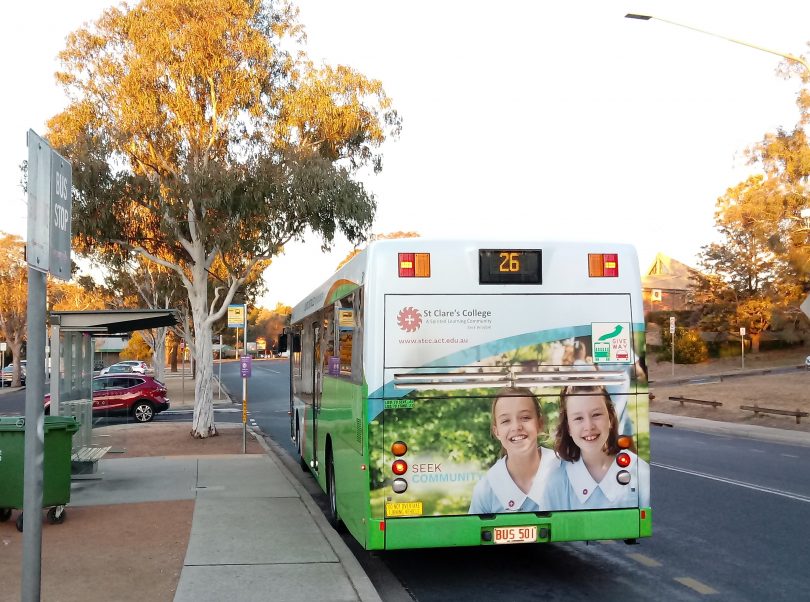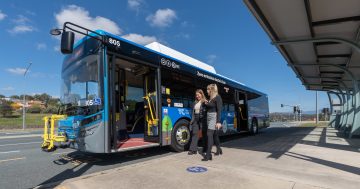
Students from 51 schools across the ACT will no longer have a dedicated bus service dropping them at school. File photo.
The Canberra Liberals have spoken out about their fears for the safety of Canberra school kids after the ACT Government revealed that 51 schools will be left without a dedicated school bus services under the new bus network.
Following a backlash from parents and schools about the proposed bus route changes and the loss of most of the dedicated school bus services, the ACT Government adjusted its plans for the new network, releasing the new plans on Tuesday morning (16 October).
After receiving 13,000 pieces of feedback regarding the proposed bus service, the new network, which is set to remain in place for the next five years, now includes an additional 78 dedicated school bus services.
While students from 51 schools across the ACT will not have a dedicated bus service dropping them at school, Minister for Transport Meegan Fitzharris said the new network would provide a better mix of dedicated school and regular buses, depending on the needs of local school communities.
But Opposition transport spokesperson Candice Burch said she still has grave concerns about the safety of school kids on public transport.
“The Canberra Liberals welcome the fact that the Government has backflipped on its radical bus overhaul and have reinstated 78 of the services they originally said they were going to cut,” Ms Burch told Region Media.
“But there are still 51 schools that will be left without a dedicated school bus service. We can see in particular that there is a very large number of primary schools on the list of schools, so all of our previous concerns around student safety are still very relevant.”
Given the recent spate of child approaches across Canberra, with the number rising to 20 reported child approaches as of last week, Ms Burch said the Canberra community and the Liberal party are very concerned for school kids’ safety on their way to and from school.

The 51 schools which will not have a dedicated bus service under the new bus network.
Ms Burch said she has been inundated with complaints from parents, grandparents, teachers and concerned school principals about student safety.
Some students will now rely on expanded local or nearby rapid services with the Government set to employ new customer service officers to familiarise school children with using interchanges. But Ms Burch said it will not stop parents from being concerned for their kids’ safety.
“The Government is talking about adding one additional Customer Service Officer at interchanges, which is not nearly enough. It still means children are very vulnerable when they are walking to and from bus stops,” she said.
“If students are on public buses with other members of the public, we can’t expect the bus driver to keep an eye out for what is happening at the back of the bus.
“We have heard about teenagers and college students who have said they have had bad encounters on buses when men have sat beside them and touched their legs. If that is happening to 16, 17, 18-year-olds on public buses, I think we should be very concerned about putting primary school students on public buses.”

Ms Fitzharris said most Canberra students don’t use public transport, with the majority of kids getting to school by car. Photo: Supplied.
Ms Fitzharris said the new bus network had been designed to encourage more students to use public transport, give families greater choice and help offer students greater flexibility while getting them to school on time.
Ms Fitzharris said the 51 schools which will not have dedicated bus services are primary, early childhood or infant schools which have very low bus patronage or high schools or colleges that are now well-served by regular route services.
“We really want to encourage more students to catch public transport to and from school, and we have worked extensively over the past few months with schools and the education sector to deliver a balanced network that will encourage more students onto buses and light rail,” Ms Fitzharris said.
“We know currently around 60 per cent of students who catch a bus to school use the regular network, so kids are very happy to catch regular buses, which are safe, flexible and easy to use.
“By changing the network so more regular buses and light rail serve schools, we give families more options and reduce travel times for students so they can get to school on time.”
Ms Fitzharris said the number one priority of the new network would be helping students navigate the system safely.
“We want students to be safe on our buses, which is why we will ensure there is more help and supervision at interchanges. We will employ more customer service officers and school crossing supervisors, improve the infrastructure around schools and provide better information to help people navigate the new network,” she said.
“There will still be 222 dedicated school bus services every day for students across the territory. These services will be simpler and easier for students to use, with most services running both morning and afternoon using the same route number.”














